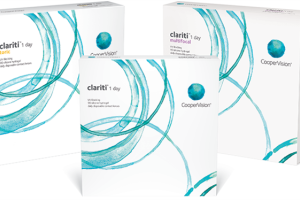Despite ECPs Reporting Increased Prevalence of Childhood Myopia,
Two-thirds of Parents Not Familiar with the Condition
SAN RAMON, Calif., November 5, 2019—One in four children in the United States is myopic1, but according to The Harris Poll survey2 results released today by CooperVision, only 33% of parents know what that term means2, or how it can affect their children’s future eyesight. This corroborates the finding that 97% of ECPs agree parents should know more about the ways they can help protect children’s vision3. The survey was conducted among United States eye care professionals (ECPs), including optometrists and ophthalmologists, and more than 1,000 U.S. parents with children between 8-15 years old regarding their knowledge of myopia.
According to the research, two-thirds of eye care professionals (66%) have seen an increase in the prevalence of pediatric myopia in their practice over the last 5-10 years3, which aligns with data from the American Optometric Association (AOA), showing myopia has become increasingly prevalent in recent years in the U.S., with an increase of 25% in the past 40 years. Around one quarter of parents (26%) have a nearsighted child, and about three quarters of those children were diagnosed between the ages of 3 and 121. But even though this condition is increasing, and the severity is getting worse, there are many misunderstandings surrounding myopia, what it is and why it is important for children to have their eyesight checked regularly by an ECP.
“My practice has seen an increasing number of children with progressive myopia in the last decade. Each time we diagnose a child, parents are often surprised and sometimes worried. I’m not surprised that nearly half of parents said they know less about their child’s eye health than they should2,” said Katherine Schuetz, OD, at Little Eyes Pediatric Care and RevolutionEYES. “An annual trip to the eye doctor is as essential as a trip to a pediatrician or dentist. This becomes even more important as myopia increases in prevalence and severity, since identifying it early is one step in making sure the child has a brighter future.”
“We know there is a lot of confusion about the significance of myopia, how it progresses and how to treat it,” says Dr. Michele Andrews, Senior Director, North America Professional and Academic Affairs at CooperVision. “It comes as no surprise that while 65% of parents claimed they were somewhat or very knowledgeable of myopia2, only one in three were able to identify myopia as nearsightedness2. There clearly needs to be more education about what childhood myopia is and why it is important to diagnose it early.”
More insights from the survey include:
- 81% of ECPs3 agree myopia is one of the biggest problems impacting children’s eyesight today, compared to 72% of parents2.
- 56% of ECPs agree that myopia, left untreated, increases the risk of irreversible vision loss later in life3.
- 73% of parents strongly/somewhat agree that teachers are more likely to notice that children have vision problems2; 68% of parents strongly/somewhat agree that school nurses often notice potential vision problems among children before parents2.
- 22% of parents report a key reason prompting an ECP visit is an in-school eye screening2, whereas 92% of ECPs state this is a reason for parents seeing them for their child’s vision3.
- 84% of ECPs wish parents spoke with them sooner about their child’s vision3, and almost half of parents wish they spoke with an ECP sooner too2.
- 84% of ECPs agree parents need to understand the younger the child is when diagnosed with myopia, the more urgent it is to address this condition3.
- 71% of ECPs rate it absolutely essential/very important to slow progression of myopia among children 8-15 years old3. 87% of ECPs say they would be interested in using contact lenses for children 8-15 with myopia in the future3.
- Parents say they are more knowledgeable about other childhood conditions including the flu (93%), ear infections (86%) and lice (80%) compared with their knowledge of myopia (65%)2.
Research Method
This survey was conducted online within the United States by The Harris Poll on behalf of CooperVision from June 27 to July 18, 2019 among 313 licensed eye care professionals, including 155 optometrists and 158 ophthalmologists who see at least 1 child age 8-15 with myopia each month, and 1,005 parents with children between 8-15 years old. Parent data were weighted by age, gender, education, race/ethnicity, region, income, household size, marital status, and employment status to be representative of the total population of US adults 18+ who are parents of a child age 8-15. Propensity score weighting was also used to adjust for respondents’ propensity to be online. Optometrist and ophthalmologist data were weighted by gender, years in practice, and region and a post-weight was applied to the total data to reflect the proportions of optometrists and ophthalmologists within the U.S. ECP population.
The comprehensive study from CooperVision and Harris includes additional information on topics such as the positive role outside plays in a child’s eye health, treatment awareness and vision correction tactics. To learn more, visit https://coopervision.com/protect-kids-vision. To access the full survey results, please contact coopervision@evolvemkd.com.
Cooper, Y. (2019, May 1). With Childhood Myopia Rates on the Rise, the American Optometric Association Highlights the Importance of Early Intervention through Annual Eye Exams. Retrieved from https://www.aoa.org/newsroom/myopia-rates-on-the-rise-syvm
CooperVision data on file 2019. Myopia Awareness, The Harris Poll online survey 6/27/19 to 7/18/19 of n=1,005 parents (with child age 8-15) in U.S.
CooperVision data on file 2019. Myopia Awareness, The Harris Poll online survey 6/27/19 to 7/18/19 of n=313 ECPs (who see at least 1/month myopic child, age 8-15) in U.S.








